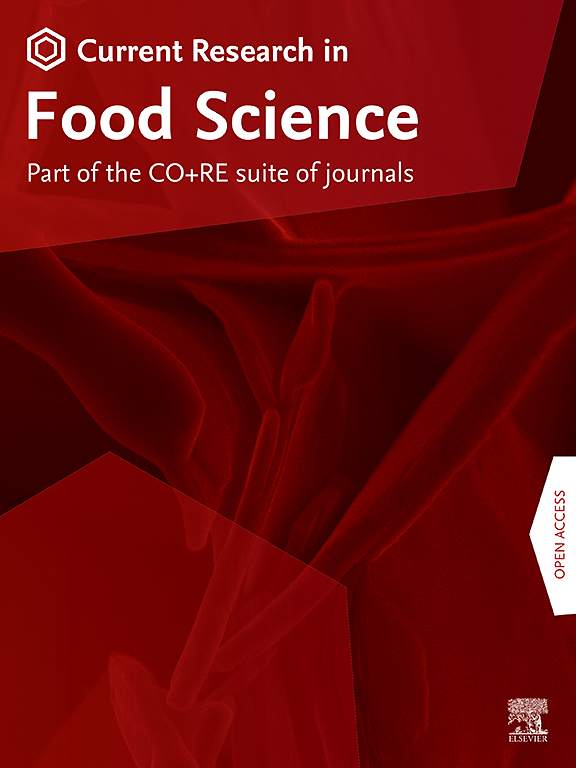Unlocking chickpea flour potential: AI-powered prediction for quality assessment and compositional characterisation
IF 7
2区 农林科学
Q1 FOOD SCIENCE & TECHNOLOGY
引用次数: 0
Abstract
The growing demand for sustainable, nutritious, and environmentally friendly food sources has placed chickpea flour as a vital component in the global shift to plant-based diets. However, the inherent variability in the composition of chickpea flour, influenced by genetic diversity, environmental conditions, and processing techniques, poses significant challenges to standardisation and quality control. This study explores the integration of deep learning models with near-infrared (NIR) spectroscopy to improve the accuracy and efficiency of chickpea flour quality assessment. Using a dataset comprising 136 chickpea varieties, the research compares the performance of several state-of-the-art deep learning models, including Convolutional Neural Networks (CNNs), Vision Transformers (ViTs), and Graph Convolutional Networks (GCNs), and compares the most effective model, CNN, against the traditional Partial Least Squares Regression (PLSR) method. The results demonstrate that CNN-based models outperform PLSR, providing more accurate predictions for key quality attributes such as protein content, starch, soluble sugars, insoluble fibres, total lipids, and moisture levels. The study highlights the potential of AI-enhanced NIR spectroscopy to revolutionise quality assessment in the food industry by offering a non-destructive, rapid, and reliable method for analysing chickpea flour. Despite the challenges posed by the limited dataset, deep learning models exhibit capabilities that suggest that further advancements would allow their industrial applicability. This research paves the way for broader applications of AI-driven quality control in food production, contributing to the development of more consistent and high-quality plant-based food products.

释放鹰嘴豆粉的潜力:用于质量评估和成分表征的人工智能预测
对可持续、营养和环境友好型食物来源的需求不断增长,使得鹰嘴豆粉成为全球向植物性饮食转变的重要组成部分。然而,受遗传多样性、环境条件和加工技术的影响,鹰嘴豆粉成分的内在变异性给标准化和质量控制带来了重大挑战。本研究探讨了将深度学习模型与近红外光谱技术相结合,提高鹰嘴豆粉质量评价的准确性和效率。使用包含136个鹰嘴豆品种的数据集,研究比较了几种最先进的深度学习模型的性能,包括卷积神经网络(CNN),视觉变形(ViTs)和图卷积网络(GCNs),并将最有效的模型CNN与传统的偏最小二乘回归(PLSR)方法进行了比较。结果表明,基于cnn的模型优于PLSR,对关键质量属性(如蛋白质含量、淀粉、可溶性糖、不溶性纤维、总脂质和水分水平)提供了更准确的预测。该研究强调了人工智能增强近红外光谱的潜力,通过提供一种无损、快速和可靠的鹰嘴豆粉分析方法,彻底改变食品行业的质量评估。尽管有限的数据集带来了挑战,但深度学习模型显示出的能力表明,进一步的进步将使其具有工业适用性。这项研究为人工智能驱动的质量控制在食品生产中的更广泛应用铺平了道路,有助于开发更一致和高质量的植物性食品。
本文章由计算机程序翻译,如有差异,请以英文原文为准。
求助全文
约1分钟内获得全文
求助全文
来源期刊

Current Research in Food Science
Agricultural and Biological Sciences-Food Science
CiteScore
7.40
自引率
3.20%
发文量
232
审稿时长
84 days
期刊介绍:
Current Research in Food Science is an international peer-reviewed journal dedicated to advancing the breadth of knowledge in the field of food science. It serves as a platform for publishing original research articles and short communications that encompass a wide array of topics, including food chemistry, physics, microbiology, nutrition, nutraceuticals, process and package engineering, materials science, food sustainability, and food security. By covering these diverse areas, the journal aims to provide a comprehensive source of the latest scientific findings and technological advancements that are shaping the future of the food industry. The journal's scope is designed to address the multidisciplinary nature of food science, reflecting its commitment to promoting innovation and ensuring the safety and quality of the food supply.
 求助内容:
求助内容: 应助结果提醒方式:
应助结果提醒方式:


